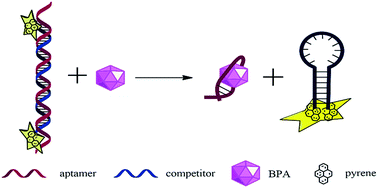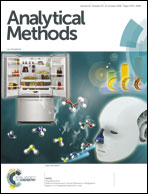A novel pyrene-switching aptasensor for the detection of bisphenol A
Abstract
BisphenolA (BPA) is an environmental endocrine disrupter which is highly harmful to human health. Although a number of traditional analysis methods, such as high performance liquid chromatography (HPLC), liquid chromatography-mass spectrometry (LC-MS), gas chromatography-mass spectrometry (GC-MS), enzyme linked immunosorbent assay (ELISA) and other biochemical tests, have been used for the measurement of BPA, these analyses are limited by the availability of commercial antibodies, need for sophisticated equipment and tedious prior sample treatment. To address these limitations, we report herein the design, synthesis and application of a competition-mediated pyrene-switching aptasensor for the selective detection of BPA in buffer and actual water samples. The detection principle is based on the attachment of pyrene molecules to both ends of a hairpin DNA strand, which becomes the partially complementary competitor to an anti-BPA aptamer. The fact that two pyrenes in close proximity to each other can form an excimer plays an important role in this method. Triggered by BPA, the molecular probe can form a hairpin structure, resulting in a fluorescence emission shift from 400 nm (pyrene monomer) to 488 nm (pyrene excimer). This method exhibits a linear detection range from 0 to 2.00 ng mL−1 for BPA with a detection limit of 0.094 ng mL−1 (3σ). In addition, the method has high selectivity for BPA and can be effectively applied to actual environmental water samples.

- This article is part of the themed collection: Analytical Methods Recent HOT articles


 Please wait while we load your content...
Please wait while we load your content...